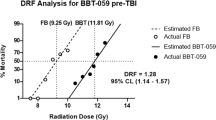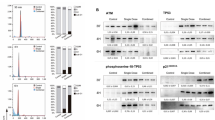Abstract
Induction of an adaptive response to ionizing radiation in mouse lymphoma (EL4) cells was studied by using cell survival fraction and apoptotic nucleosomal DNA fragmentation as biological end points. Cells in early log phase were pre-exposed to low dose of γ-rays (0.01 Gy) 4 or 20 hrs prior to high dose γ-ray (4, 8 and 12 Gy for cell survival fraction analysis; 8 Gy for DNA fragmentation analysis) irradiation. Then cell survival fractions and the extent of DNA fragmentation were measured. Significant adaptive response, increase in cell survival fraction and decrease in the extent of DNA fragmentation were induced when low and high dose γ-ray irradiation time interval was 4 hr. Addition of protein or RNA synthesis inhibitor, cycloheximide or 5,6-dichloro-1-β-d-ribofuranosylbenzimidazole (DRFB), respectively during adaptation period, the period from low dose γ-ray irradiation to high dose γ-ray irradiation, was able to inhibit the induction of adaptive response, which is the reduction of the extent DNA fragmentation in irradiated EL4 cells. These data suggest that the induction of adaptive response to ionizing radiation in EL4 cells required both protein and RNA synthesis.
Similar content being viewed by others
References Cited
Abend, M., Rhein, A., Gilbertz, K.-P., Blakely, W. F., and van Beuningen, D., Correlation of micronucleus and apoptosis assays with reproductive cell death.Int. J. Radiat. Biol., 3, 315–326 (1995).
Arends, M. J., Morris, R. G. and Wyllie A. H., Apoptosis. The role of the endonuclease.Am. J. Pathol., 136, 593 (1990).
Azzam, E. I., Raaphorst, G. P. and Mitchel, R. E. J., Radiation-induced adaptive response for protection against micronucleus formation and neoplastic transformation in C3H 10T1/2 mouse embryo cells.Radiat. Res., 138, S28-S31 (1994).
Bosi, A. and Olivieri, G., Variability of the adaptive response to ionizing radiation in humans.Mutation Res., 211, 13–17 (1989).
Boothman, D. A., Bouvard, I. and Hughes, E. N., Identification and characterization of X-ray-induced proteins in human cells.Cancer Res., 49, 2871–2878 (1989).
Bump, E. A., Braunhut, S. J., Palayoor, S. T., Medeiros, D., Lai, L. L., Cerce, B. A., Langley, R. E., and Coleman, C. N., Novel concepts in modification of radiation sensitivity.Int. J. Radiat. Oncology Biol. Phys., 29, 249–253 (1994).
Cai, L. and Lui, S.-Z., Induction of cytogenetic adaptive response of somatic and germ cellsin vivo andin vitro by low-dose X-irradiation.Int. J. Radiat. Biol., 58, 187–194 (1990).
Cortes, F., Domingoez, I., Mateos, S., Pinero, J., and Mateos, J. C., Evidence for an adaptive response to radiation damage in plant cells conditioned with X-rays or incorporated tritium.Int. J. Radiat. Biol., 57, 537–541 (1990).
Fenech, M. and Morley, A. A., Measurement of micronuclei in lymphocytes.Mutation Res., 147, 29–36 (1985).
Ikushima, T., Chromosomal response to ionizing radiation reminiscent of an adaptive response in cultured hamster cells.Mutation Res., 180, 215–221 (1987).
Kartasova, T., Ponec, M. and van de Putte, P., Induction of proteins and mRNAs after uv irradiation of human epidermal keratinocytes.Exp. Cell Res., 174, 421–432 (1988).
Kim, J. H., Lee, K. J., Cho, C. K., Yoo, S. Y., Kim, T. W., and Kim, S. H., Adaptive response induced by low dose ionizing radiation in human lymphocytes.J. Korean Asso. Radiat. Prot., 20, 96–102 (1995a).
Kim, J. H., Lee, K. J., Cho, C. K., Yoo, S. Y., Kim, T. W., Ji, Y. H. and Kim, S. H., Adpative response induced by low dose ionizing radiation in human cervical carcinoma cells.Arch. Pharm. Res., 18, 410–414 (1995b).
Kim, J. H., Hahm, K. H., Cho, C. K. and Yoo, S. Y., Protein biosynthesis in low dose ionizing radiation-adapted human melanoma cells.J. Radiat. Res., 37, 161–169 (1996).
Nelipovich, P. A., Nikonova, L. V. and Umansky, S. R., Inhibition of poly (ADP-ribose) polymerase as a possible role for activation of Ca2+/Mg2+-dependent endonuclease in thymocytes of irradiated rats.Int. J. Radiat. Biol., 53, 749–765 (1988).
Olivieri, G., Bodycote, J. and Wolff, S., Adpative response of human lymphocytes to low concentrations of radioactive thymidin.Science, 223, 594–597 (1984).
Ono, K., Masunaga, S., Akaboshi, M. and Akuta, K., Estimation of the initial slope of the cell survival curne after irradiation from micronucleus frequency in cytokinesis- blocked cell.Radiat. Res., 138, S101-S104 (1994).
Prasad, A. V., Mohan, N., Chandrasekar, B., and Meltz, M. L., Avtivation of nuclear factor kB in human lymphoblastoid cells by low-dose ionizing radiation.Radiat. Res., 138, 367–372 (1994).
Prasad, A. V., Mohan, N., Chandrasekar, B., and Meltz, M. L., Induction of transcription of “immediate early genes” by low-dose ionizing radiation.Radiat. Res., 143, 263–272 (1995).
Radford, I. R., Murphy, T. K., Radley, J. H. and Ellis, S. L., Radiation response of mouse lymphoid and myeloid cell lines. Part II. Apoptotic death is shown by all lines examined.Int. J. Radiat. Biol., 65, 217–227 (1994).
Sanderson, B. J. S. and Morley, A. A., Exposure of human lymphocytes to ionizing radiation reduces mutagenesis by subsequent ionizing radiation.Mutation Res., 164, 347–351 (1986).
Sambrook, J., Fritsch, E. F., and Maniatis, T.,Molecular Cloning: A Laboratory Manual. Cold Spring Harbor Laboratory, New York, (1989).
Samson, L. and Cairns, J., A new pathway for DNA repair inEscherichia coli.Nature, 267, 281–282 (1977).
Sellins, K. S. and Cohen, J. J., Gene induction by γ-irradiation leads to DNA fragmentation in lymphocytes.J. immunol., 139, 3199–3206 (1987).
Shadley, J. D., Afzal, V., and Wolff, S., Characterization of the adaptive response to ionizing radiation induced by low doses of X rays to human lymphocytes.Radiat. Res., 111, 511–517 (1987).
Shadley, J. D. and Wiencke, J. K., Induction of the adaptive response by X-rays is dependent on radiation intensity.Int. J. Radiat. Biol., 56, 107–118 (1989).
Shadley, J. D. and Wolff, S., Very low doses of X-rays can cause human lymphocytes to become less susceptible to ionizing radiation.Mutagenesis, 2, 95–96 (1987).
Soldatenkov, V. A., Prasad, S., Notario, V., and Dritschilo, A., Radiation-induced apoptosis of Ewing’s sarcoma cells: DNA fragmentation and proteolysis of poly(ADP-ribose) polymerase.Cancer Res., 55, 4240–4242 (1995).
Umansky, S. R., The genetic program of cell death. Hypothesis and some applications: Transformation, carcinogenesis, ageing.J. Theor. Biol., 97, 591 (1982).
Wiencke, J. K., Afzal, V., Olivieri, G. and Wolff, S., Evidence [3H]thymidine-induced adaptive response of human lymphocytes to subsequent doses of X-rays involves the induction of a chromosomal repair mechanism.Mutagenesis, 1, 375–380 (1986).
Wyllie, A. H., Glucocorticoid-induced thymocyte apoptosis is associated with endogenous endonuclease activation.Nature, 284, 555 (1980).
Wolff, S., Afzal, V., Wiencke, J. K., Olivieri, G., and Michael, A., Human lymphocytes exposed to low doses of ionizing radiations become refactory to high doses of radiation as well as chemical mutagens that induce double-strand breaks in DNA.Int. J. Radiat. Biol., 53, 39–48 (1988).
Author information
Authors and Affiliations
Rights and permissions
About this article
Cite this article
Kim, J.H., Hyun, SJ., Yoon, MY. et al. Pretreatment of low dose radiation reduces radiation-induced apoptosis in mouse lymphoma (EL4) cells. Arch. Pharm. Res. 20, 212–217 (1997). https://doi.org/10.1007/BF02976147
Received:
Issue Date:
DOI: https://doi.org/10.1007/BF02976147




